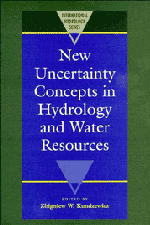Book contents
- Frontmatter
- Contents
- List of Authors
- Preface
- I INTRODUCTION
- II FACETS OF UNCERTAINTY
- III NOVEL APPROACHES TO UNCERTAINTY: FRACTALS, FUZZY SETS AND PATTERN RECOGNITION, NON-PARAMETRIC METHODS
- IV RANDOM FIELDS
- 1 Analysis of regional drought characteristics with empirical orthogonal functions
- 2 Worth of radar data in real-time prediction of mean areal rainfall by nonadvective physically-based models
- 3 Uncertainty analysis in radar-rainfall estimation
- 4 Design of groundwater monitoring networks for landfills
- 5 Spatial variability of evaporation from the land surface – random initial conditions
- 6 Detecting outliers in flood data with geostatistical methods
- V TIME SERIES AND STOCHASTIC PROCESSES
- VI RISK, RELIABILITY AND RELATED CRITERIA
2 - Worth of radar data in real-time prediction of mean areal rainfall by nonadvective physically-based models
Published online by Cambridge University Press: 07 May 2010
- Frontmatter
- Contents
- List of Authors
- Preface
- I INTRODUCTION
- II FACETS OF UNCERTAINTY
- III NOVEL APPROACHES TO UNCERTAINTY: FRACTALS, FUZZY SETS AND PATTERN RECOGNITION, NON-PARAMETRIC METHODS
- IV RANDOM FIELDS
- 1 Analysis of regional drought characteristics with empirical orthogonal functions
- 2 Worth of radar data in real-time prediction of mean areal rainfall by nonadvective physically-based models
- 3 Uncertainty analysis in radar-rainfall estimation
- 4 Design of groundwater monitoring networks for landfills
- 5 Spatial variability of evaporation from the land surface – random initial conditions
- 6 Detecting outliers in flood data with geostatistical methods
- V TIME SERIES AND STOCHASTIC PROCESSES
- VI RISK, RELIABILITY AND RELATED CRITERIA
Summary
ABSTRACT The utilization of operationally available radar data for improved shortterm predictions of mean areal rainfall on hydrologic scales can be accomplished by the use of a physically-based spatially-lumped rainfall prediction model. The state-space form of such a model admits covariance estimation algorithms for the determination of rainfall forecast variance. In particular, when the model is linear in the state, covariance analysis can be performed without the use of radar reflectivity data. Covariance analysis of a particular linear physically-based model indicates that the utility of the radar reflectivity data of various elevation angles is limited in mean areal rainfall predictions, even when a very small density of rain gauges exists over the region of interest and good quality radar data are used. This applies to both raw reflectivity and radar-rainfall data converted through a Z–R relationship. The ratio of mean areal rainfall prediction variances, defined as variance with radar data divided by variance without radar data, was found to be greater than 0.8 in most cases. On the other hand, the radar data reduced the estimated variance of the vertically-integrated liquid water content considerably, even when high density rain gauge data were present. The conclusions of this study are representative of covariance analyses procedures that require linear or linearized rainfall prediction models and, for such procedures, are independent of the particular model used. On the other hand, the model used is a spatially-lumped model and can not utilize information on storm velocity offered by the radar data time series.
- Type
- Chapter
- Information
- New Uncertainty Concepts in Hydrology and Water Resources , pp. 168 - 180Publisher: Cambridge University PressPrint publication year: 1995



